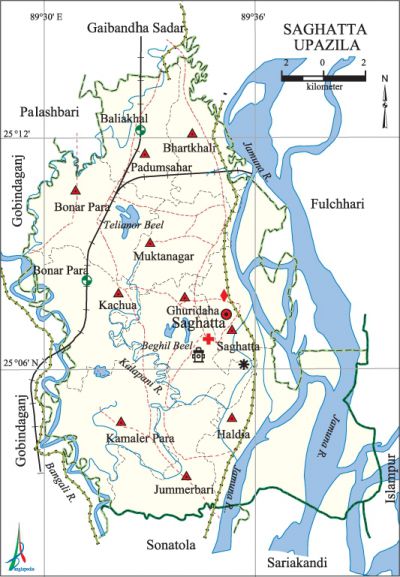Saghatta Upazila
Saghatta Upazila (gaibandha district) area 231.02 sq km, located in between 25°02' and 25°14' north latitudes and in between 89°29' and 89°40' east longitudes. It is bounded by gaibandha sadar upazila on the north, sonatala upazila on the south, fulchhari, sariakandi and islampur upazilas on the east, gobindaganj and palashbari upazilas on the west.
Population Total 267819; male 130606, female 137213; Muslim 249241, Hindu 18345, Buddhist 4, and others 229.
Water bodies Main rivers: jamuna, bangali, Kalapani; Telian Beel, Badia Beel are notable.
Administration Saghatta Thana was formed in 1905 and it was turned into an upazila in 1984.
| Upazila | ||||||||
| Municipality | Union | Mouza | Village | Population | Density (per sq km) | Literacy rate (%) | ||
| Urban | Rural | Urban | Rural | |||||
| - | 10 | 116 | 130 | 15883 | 251936 | 1159 | 46.8 (2001) | 33.5 (2001) |
| Upazila Town | ||||||||
|
Area (sq km) |
Mouza |
Population |
Density (per sq km) |
Literacy rate (%) | ||||
| 6.37 | 4 | 15883 | 2493 | 46.84 (2001) | ||||
| Union | ||||
| Name of union and GO code | Area (acre) | Population | Literacy rate (%) (2001) | |
| Male | Female | |||
| Kachua 57 | 5219 | 13402 | 13794 | 32.77 |
| Kamaler Para 66 | 6183 | 17650 | 18270 | 30.83 |
| Ghuridaha 28 | 5148 | 12742 | 13368 | 31.92 |
| Jummerbari 47 | 4478 | 14762 | 15284 | 31.05 |
| Padumsahar 76 | 5653 | 12595 | 13880 | 35.27 |
| Bonar Para 19 | 5661 | 16001 | 16626 | 41.72 |
| Bhartkhali 13 | 3521 | 11125 | 12167 | 42.62 |
| Muktanagar 95 | 3647 | 10326 | 11426 | 36.45 |
| Saghatta 85 | 6019 | 11010 | 11529 | 34.74 |
| Haldia 38 | 11557 | 10993 | 10869 | 24.60 |
Source Bangladesh Population Census 2001 and 2011, Bangladesh Bureau of Statistics.

Archaeological heritage and relics Bharatkhali Kalibari Mandir (eighteenth century), Kachari (revenue office) of Bharatkhali Zamindar.
War of Liberation During the war of liberation an encounter was held between the freedom fighters and the Pak army at a place called the Bhanga Mor (road turning point) at one end of the Saghatta upazila area, in which one Pak Major and a soldier were killed. In another encounter at Trimohoni Ghat, 27 Pak soldiers were killed and so were 12 freedom fighters. During the War of Liberation the freedom fighters killed 17 razakars of the upazila. The Pak army destroyed the Bridge on the Badiakhali Road and the Singra Railway Bridge. They also set the Bharatkhali Jute godown on fire. One Memorial monument was built at the Muktanagar High School ground.
For details: See সাঘাটা উপজেলা, বাংলাদেশ মুক্তিযুদ্ধ জ্ঞানকোষ (Encyclopedia of Bangladesh War of Liberation), বাংলাদেশ এশিয়াটিক সোসাইটি, ঢাকা ২০২০, খণ্ড ১০।
Religious institutions Mosque 345, temple 22.
Literacy rate and educational institutions Average literacy 40.6%; male 45.0%, female 36.4%. Educational institutions: college 6, secondary school 39, primary school 142, community school 14, madrasa 16. Noted educational institutions: Abdullah Memorial Government Primary School, Jummerbari High School (1903), Saghatta Pilot High School (1904), Kazi Azhar Ali High School (1920), Bhartkhali High School (1940).
Newspapers and periodicals Weekly: Panthasala.
Cultural organisations Library 1, club 30, shilpakala academy 1, music academy 1, theatre group 2, cinema hall 4,' playground 21, women's society 15.
Tourists spots Bhartkhali Kalibari Mandir.
Main sources of income Agriculture 67.63%, non-agricultural labourer 1.97%, industry 1.11%, commerce 11.20%, transport and communication 3.57%, service 6.44%, construction 0.90%, religious service 0.90%, rent and remittance 0.30% and others 6.69%.
Ownership of agricultural land Landowner 58.99%, landless 41.01%; agricultural landowner: urban 43.68% and rural 59.98%.
Main crops Paddy, jute, potato, wheat, onion, garlic, vegetables.
Extinct or nearly extinct crops Sugarcane, aus paddy, kaun, china, sweet potato, linseed, sesame.
Main fruits Mango, jackfruit, litchi, banana, papaya, guava.
Fisheries, dairies and poultries Fishery 43, dairy 23, poultry 62.
Communication facilities Pucca road 128 km, mud road 402 km; railway 20 km; waterway 10 km.
Extinct or nearly extinct traditional transport Palanquin, horse carriage, bullock cart.
Noted manufactories Cotton mill, ice factory, saw mill, welding factory.
Cottage industries Goldsmith, blacksmith, potteries, handicraft, bamboo work, wood work.
Hats, bazars and fairs Hats and bazars are 19, fairs 5, most noted of which are Saghatta Hat, Bonar Para Hat, Bhartkhali Hat, Kachua Hat, Jummerbari Hat and Bhartkhali Kalibari Mela.
Main exports Jute, onion, garlic, banana, papaya.
Access to electricity All the unions of the upazila are under rural electrification net-work. However 31.3% of the dwelling households have access to electricity.
Sources of drinking water Tube-well 96.7%, tap 0.1% and others 3.2%.
Sanitation 33.3% of dwelling households of the upazila use sanitary latrines and 51.1% of dwelling households use non-sanitary latrines; 15.6% of households do not have latrine facilities
Health centres Upazila health complex 1, family planning centre 10, satellite clinic 2.
NGO activities Operationally important NGOs are brac, thengamara mahila sabuj sangha. [Md. Hamidul Haque Chandan]
References Bangladesh Population Census 2001 and 2011, Bangladesh Bureau of Statistics; Cultural survey report of Saghatta Upazila 2007.
